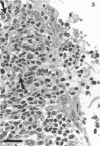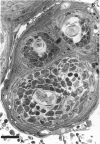Abstract
Material from 25 human palatine tonsils was studied by light microscopy, immunocytochemistry, scanning and transmission electron microscopy. Special attention was focused on the structure of the epithelium lining the tonsillar crypts in the context of its ascribed immunological functions. This epithelium was not uniform and contained patches of stratified squamous nonkeratinising epithelium and patches of reticulated sponge-like epithelium. The degree of reticulation of the epithelial cells and the infiltration of nonepithelial cells varied. Reticulated patches were associated with disruptions in the continuity of basement membrane, and often also with desquamation of the upper cell layers, and contained numerous small blood vessels. The epithelial cells showed considerable variation in their morphology when surrounded by infiltrating cells. The rearrangement of their cytoskeleton and redistribution of desmosomal contacts indicate the responsiveness and dynamic nature of such epithelium. Cytoplasmic glycogen granules, located in the upper strata, suggest the possibility of energy-demanding functions such as absorption and secretion. The numerous membrane-coating granules may have contributed to cell membrane thickening and possibly also to tonsillar mucosal protection. Some areas contained a few keratohyalin granules but there was little evidence of keratinisation. The presence, and sometimes the predominance, of nonepithelial cells was characteristic of the reticulated epithelium. T and B cells often infiltrated the whole epithelial thickness, and many plasma cells were located around intraepithelial vessels, while macrophages and interdigitating cells showed a patchy distribution. It is proposed that the major functions of the reticulated epithelium are: (1) to provide a favourable environment for the intimate contact between the effector cells of immune responses; (2) to facilitate direct transport of antigens; (3) to synthesise the secretory component continually; and (4) to contain a pool of immunoglobulins. Thus the reticulated epithelium lining the tonsillar crypts represents a specialised compartment, important in the immunological functions of the tonsil as a whole.
Full text
PDF




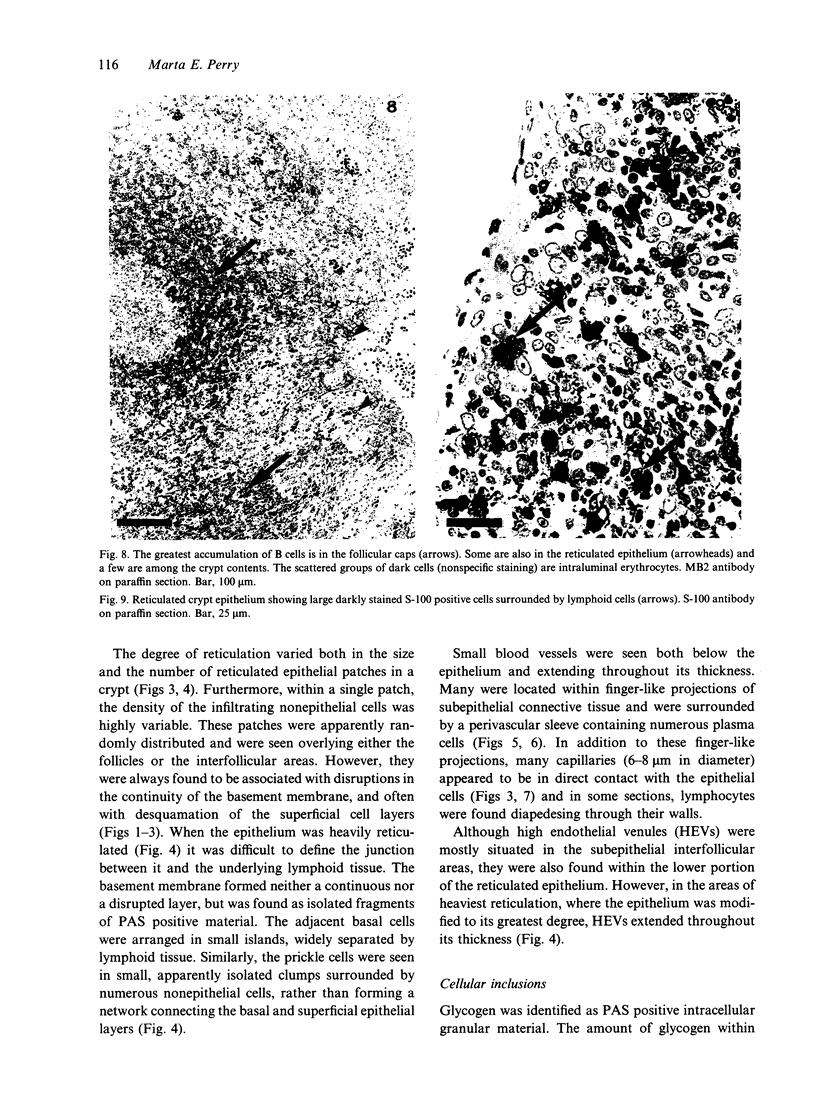

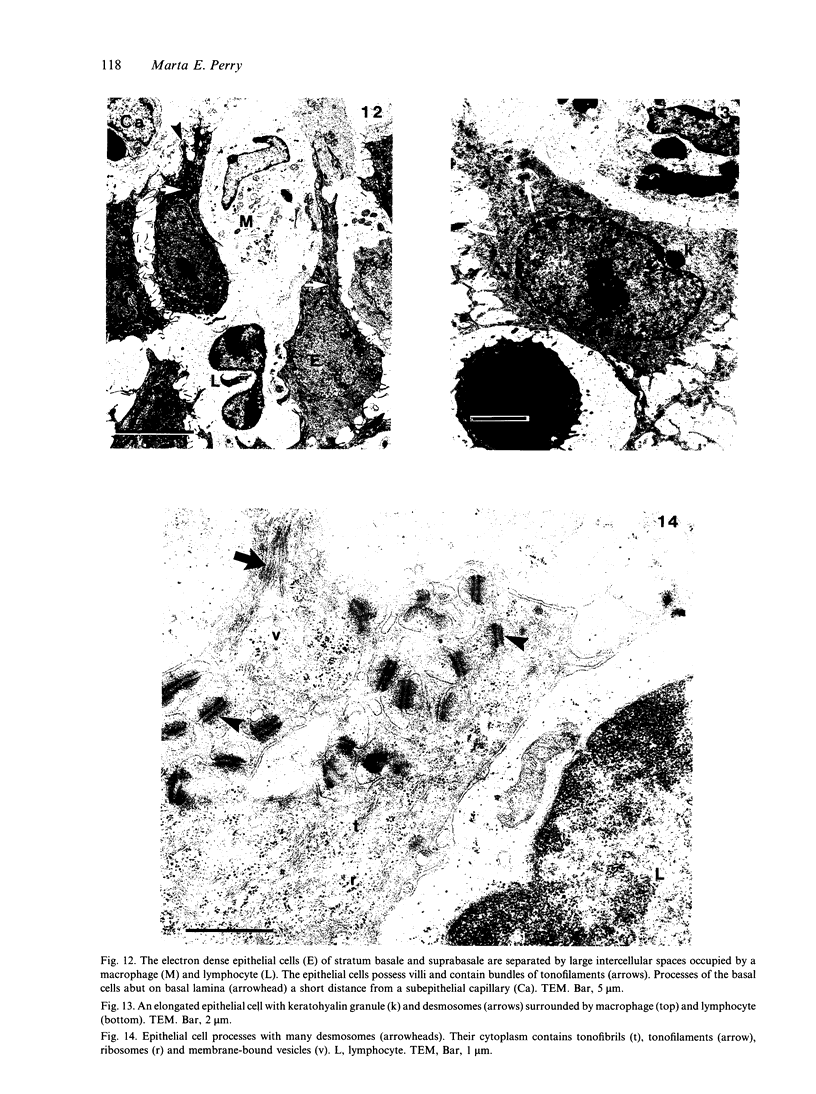
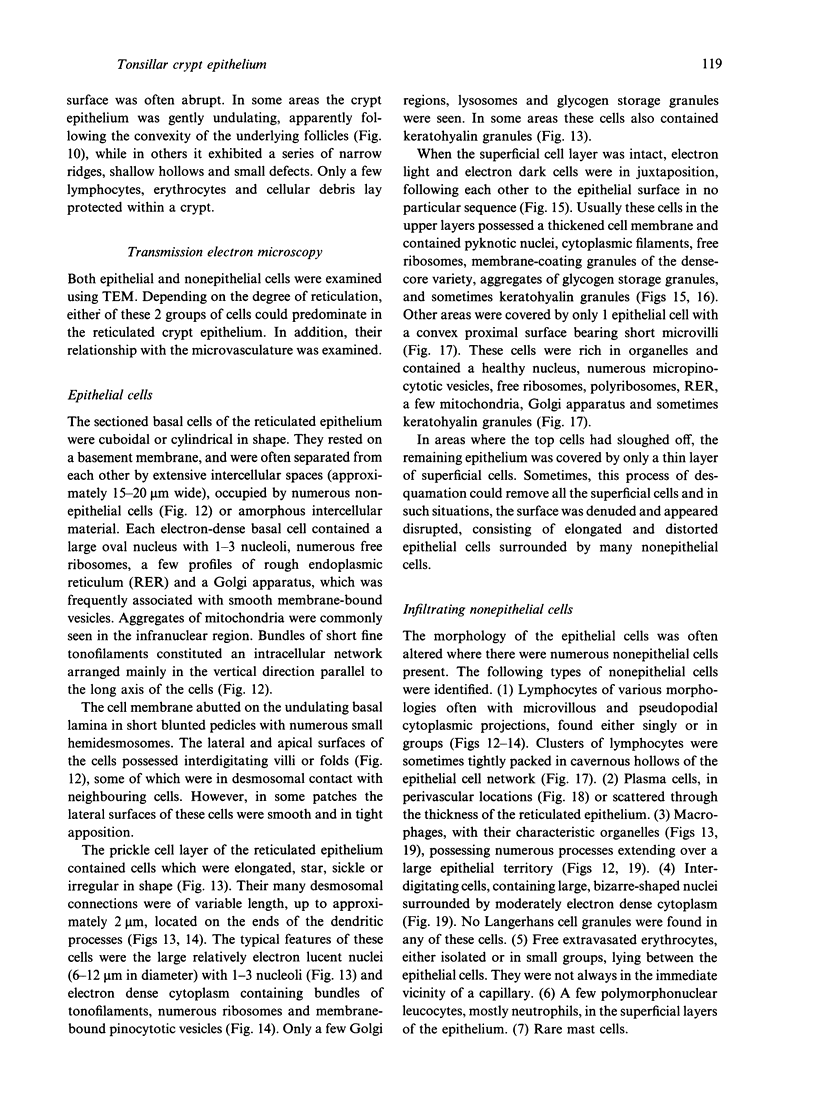


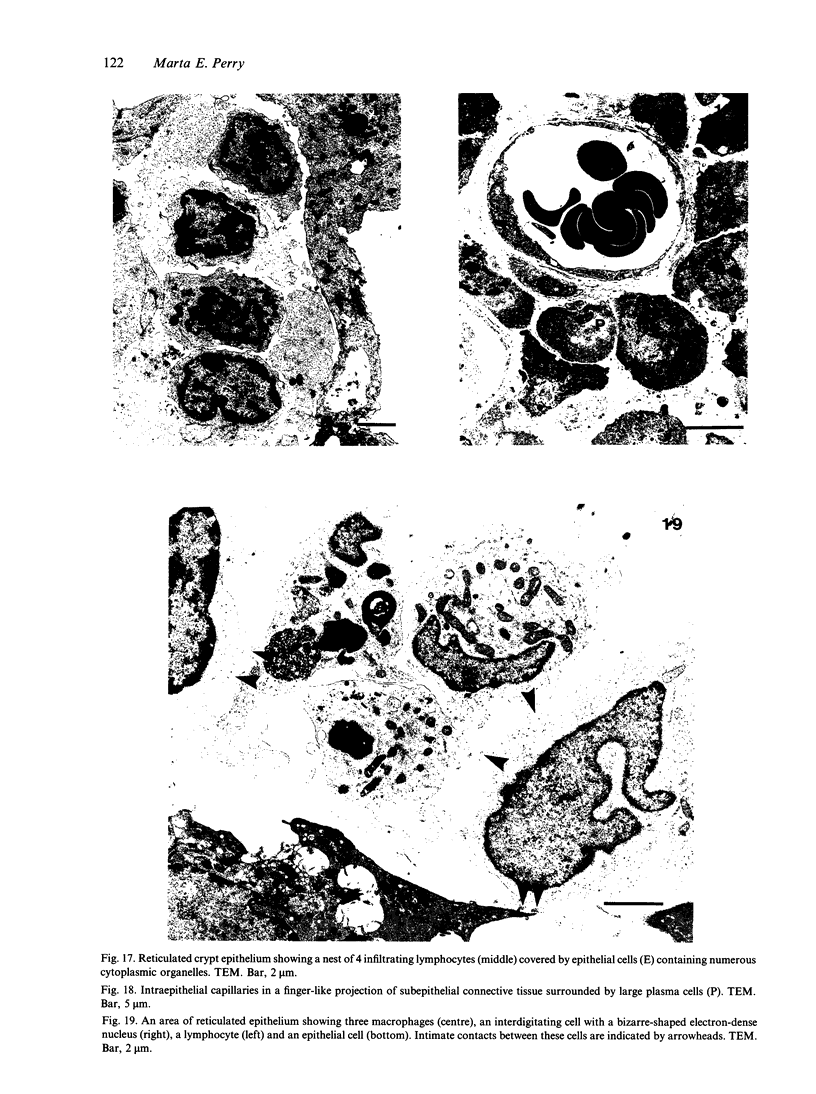



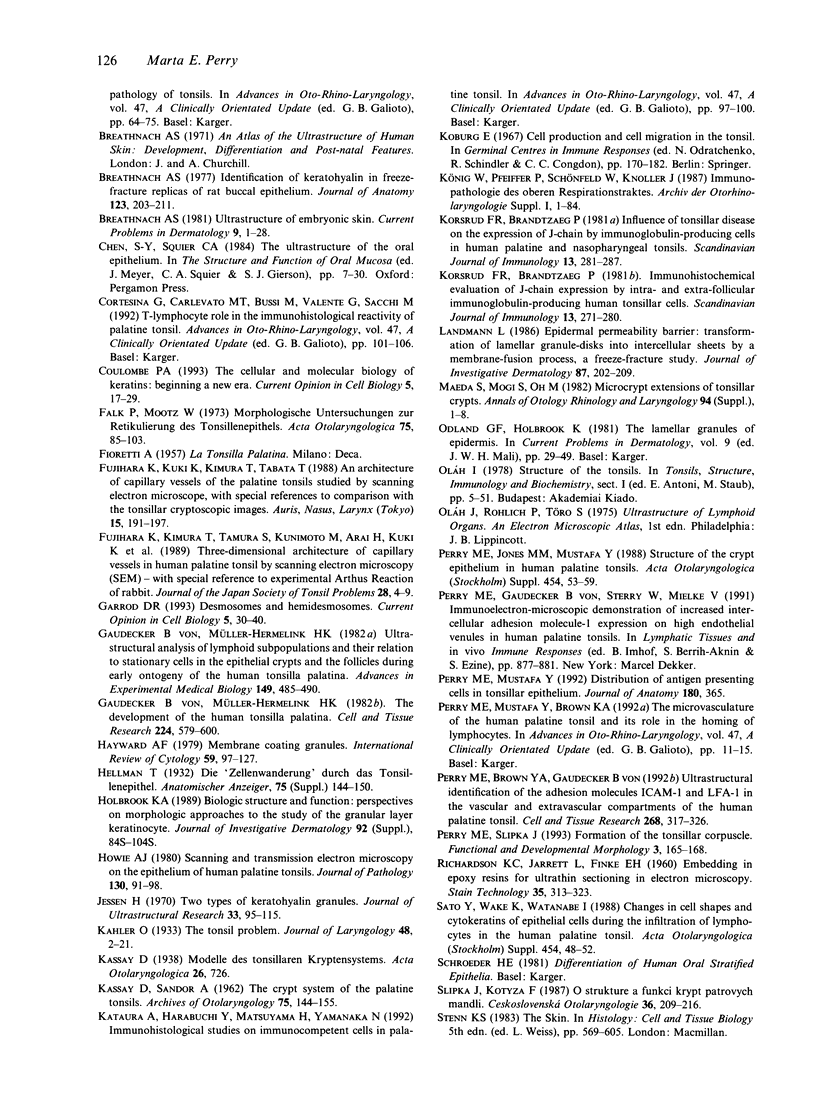

Images in this article
Selected References
These references are in PubMed. This may not be the complete list of references from this article.
- Abbey K., Kawabata I. Computerized three-dimensional reconstruction of the crypt system of the palatine tonsil. Acta Otolaryngol Suppl. 1988;454:39–42. doi: 10.3109/00016488809125002. [DOI] [PubMed] [Google Scholar]
- Brandtzaeg P. Immunopathological alterations in tonsillar disease. Acta Otolaryngol Suppl. 1988;454:64–69. doi: 10.3109/00016488809125007. [DOI] [PubMed] [Google Scholar]
- Breathnach A. S. Identification of keratohyalin in freeze-fracture replicas of rat buccal epithelium. J Anat. 1977 Feb;123(Pt 1):203–211. [PMC free article] [PubMed] [Google Scholar]
- Breathnach A. S. Ultrastructure of embryonic skin. Curr Probl Dermatol. 1981;9:1–28. [PubMed] [Google Scholar]
- Cortesina G., Carlevato M. T., Bussi M., Valente G., Sacchi M., Palestro G. T-lymphocyte role in the immunological reactivity of palatine tonsil. Adv Otorhinolaryngol. 1992;47:101–106. doi: 10.1159/000421726. [DOI] [PubMed] [Google Scholar]
- Coulombe P. A. The cellular and molecular biology of keratins: beginning a new era. Curr Opin Cell Biol. 1993 Feb;5(1):17–29. doi: 10.1016/s0955-0674(05)80004-3. [DOI] [PubMed] [Google Scholar]
- Falk P., Mootz W. Morphologische Untersuchungen zur Retikulierung des Tonsillenepithels. Acta Otolaryngol. 1973 Feb-Mar;75(2):85–103. [PubMed] [Google Scholar]
- Fujihara K., Kuki K., Kimura T., Tabata T. An architecture of capillary vessels of the palatine tonsils studied by scanning electron microscope--with special references to comparison with the tonsillar cryptscopic images. Auris Nasus Larynx. 1988;15(3):191–197. doi: 10.1016/s0385-8146(88)80027-0. [DOI] [PubMed] [Google Scholar]
- Garrod D. R. Desmosomes and hemidesmosomes. Curr Opin Cell Biol. 1993 Feb;5(1):30–40. doi: 10.1016/s0955-0674(05)80005-5. [DOI] [PubMed] [Google Scholar]
- Hayward A. F. Membrane-coating granules. Int Rev Cytol. 1979;59:97–127. doi: 10.1016/s0074-7696(08)61661-7. [DOI] [PubMed] [Google Scholar]
- Holbrook K. A. Biologic structure and function: perspectives on morphologic approaches to the study of the granular layer keratinocyte. J Invest Dermatol. 1989 Apr;92(4 Suppl):84S–104S. doi: 10.1111/1523-1747.ep13075079. [DOI] [PubMed] [Google Scholar]
- Howie A. J. Scanning and transmission electron microscopy on the epithelium of human palatine tonsils. J Pathol. 1980 Feb;130(2):91–98. doi: 10.1002/path.1711300205. [DOI] [PubMed] [Google Scholar]
- Jessen H. Two types of keratohyalin granules. J Ultrastruct Res. 1970 Oct;33(1):95–115. doi: 10.1016/s0022-5320(70)90120-6. [DOI] [PubMed] [Google Scholar]
- KASSAY D., SANDOR A. The crypt system of the palatine tonsils. Arch Otolaryngol. 1962 Feb;75:144–155. doi: 10.1001/archotol.1962.00740040150013. [DOI] [PubMed] [Google Scholar]
- Kataura A., Harabuchi Y., Matsuyama H., Yamanaka N. Immunohistological studies on immunocompetent cells in palatine tonsil. Adv Otorhinolaryngol. 1992;47:97–100. doi: 10.1159/000421725. [DOI] [PubMed] [Google Scholar]
- Korsrud F. R., Brandtzaeg P. Immunohistochemical evaluation of J-chain expression by intra- and extra-follicular immunoglobulin-producing human tonsillar cells. Scand J Immunol. 1981;13(3):271–280. doi: 10.1111/j.1365-3083.1981.tb00135.x. [DOI] [PubMed] [Google Scholar]
- Korsrud F. R., Brandtzaeg P. Influence of tonsillar disease on the expression of J chain by immunoglobulin-producing cells in human palatine and nasopharyngeal tonsils. Scand J Immunol. 1981;13(3):281–287. doi: 10.1111/j.1365-3083.1981.tb00136.x. [DOI] [PubMed] [Google Scholar]
- König W., Pfeiffer P., Schönfeld W., Knöller J. Immunpathologie des oberen Respirationstraktes. Arch Otorhinolaryngol Suppl. 1987;1:1–84. [PubMed] [Google Scholar]
- Landmann L. Epidermal permeability barrier: transformation of lamellar granule-disks into intercellular sheets by a membrane-fusion process, a freeze-fracture study. J Invest Dermatol. 1986 Aug;87(2):202–209. doi: 10.1111/1523-1747.ep12695343. [DOI] [PubMed] [Google Scholar]
- Maeda S., Mogi G., Oh M. Microcrypt extensions of tonsillar crypts. Ann Otol Rhinol Laryngol Suppl. 1982 Jul-Aug;94:1–8. [PubMed] [Google Scholar]
- Odland G. F., Holbrook K. The lamellar granules of epidermis. Curr Probl Dermatol. 1981;9:29–49. doi: 10.1159/000403343. [DOI] [PubMed] [Google Scholar]
- Perry M. E., Brown K. A., von Gaudecker B. Ultrastructural identification and distribution of the adhesion molecules ICAM-1 and LFA-1 in the vascular and extravascular compartments of the human palatine tonsil. Cell Tissue Res. 1992 May;268(2):317–326. doi: 10.1007/BF00318800. [DOI] [PubMed] [Google Scholar]
- Perry M. E., Jones M. M., Mustafa Y. Structure of the crypt epithelium in human palatine tonsils. Acta Otolaryngol Suppl. 1988;454:53–59. doi: 10.3109/00016488809125005. [DOI] [PubMed] [Google Scholar]
- Perry M. E., Mustafa Y., Brown K. A. The microvasculature of the human palatine tonsil and its role in the homing of lymphocytes. Adv Otorhinolaryngol. 1992;47:11–15. doi: 10.1159/000421711. [DOI] [PubMed] [Google Scholar]
- Perry M. E., Slípka J. Formation of the tonsillar corpuscle. Funct Dev Morphol. 1993;3(3):165–168. [PubMed] [Google Scholar]
- RICHARDSON K. C., JARETT L., FINKE E. H. Embedding in epoxy resins for ultrathin sectioning in electron microscopy. Stain Technol. 1960 Nov;35:313–323. doi: 10.3109/10520296009114754. [DOI] [PubMed] [Google Scholar]
- Sato Y., Wake K., Watanabe I. Changes in cell shapes and cytokeratins of epithelial cells during the infiltration of lymphocytes in the human palatine tonsils. Acta Otolaryngol Suppl. 1988;454:48–52. doi: 10.3109/00016488809125004. [DOI] [PubMed] [Google Scholar]
- Slípka J., Kotyza F. O strukture a funkci krypt patrových mandlí. Cesk Otolaryngol. 1987 Jul;36(4):209–216. [PubMed] [Google Scholar]
- Yamamoto Y., Okato S., Takahashi H., Takeda K., Magari S. Distribution and morphology of macrophages in palatine tonsils. Acta Otolaryngol Suppl. 1988;454:83–95. doi: 10.3109/00016488809125010. [DOI] [PubMed] [Google Scholar]
- von Gaudecker B., Muller-Hermelink H. K. Ultrastructural analysis of lymphoid subpopulations and their relation to stationary cells in the epithelial crypts and the follicles during early ontogeny of the human tonsilla palatina. Adv Exp Med Biol. 1982;149:485–490. doi: 10.1007/978-1-4684-9066-4_68. [DOI] [PubMed] [Google Scholar]
- von Gaudecker B., Müller-Hermelink H. K. The development of the human tonsilla palatina. Cell Tissue Res. 1982;224(3):579–600. doi: 10.1007/BF00213754. [DOI] [PubMed] [Google Scholar]





